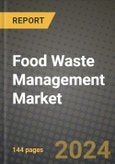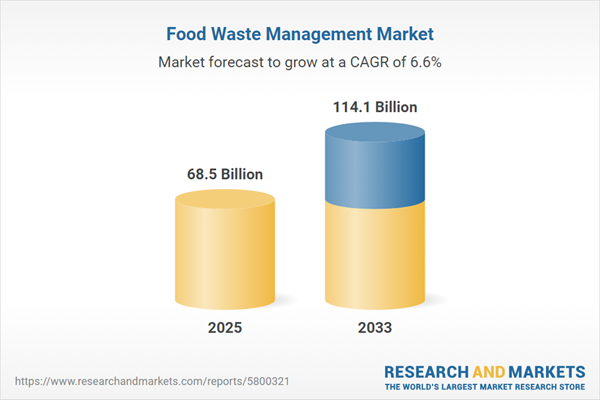Food Waste Management Market Overview
- The Food Waste Management Market is gaining momentum as governments, businesses, and consumers seek sustainable solutions to tackle the growing challenge of food waste. Every year, millions of tons of food are discarded across the supply chain, from production and distribution to retail and households. This has significant economic, environmental, and social implications, including resource wastage, greenhouse gas emissions, and food insecurity. The rising awareness of these issues is driving increased investment in food waste prevention, recycling, and valorization technologies. Solutions such as composting, anaerobic digestion, and waste-to-energy conversion are being widely adopted, alongside digital tools that help track and reduce waste. Additionally, regulations and initiatives such as landfill bans and food donation incentives are pushing businesses to implement structured waste management strategies. As industries continue to seek innovative and cost-effective solutions, the food waste management market is poised for steady growth, with strong contributions from both public and private sectors.
- In 2024, the food waste management landscape has seen significant advancements driven by stringent regulations and technological innovations. Governments worldwide have strengthened policies around food waste reduction, with stricter mandates on waste segregation, disposal, and reporting. The hospitality and retail sectors have ramped up their efforts, leveraging AI-powered inventory management systems to optimize food purchasing and reduce spoilage. Additionally, food rescue organizations and redistribution platforms have expanded, enabling surplus food to be efficiently redirected to those in need. The adoption of anaerobic digestion facilities has grown, converting organic waste into biogas and biofertilizers, contributing to the circular economy. Moreover, major food producers are integrating upcycling techniques, transforming byproducts and surplus ingredients into new consumer goods. While progress is being made, challenges such as inefficient waste collection systems and high infrastructure costs remain, requiring further collaboration between policymakers, businesses, and technology providers.
- Looking ahead to 2025 and beyond, the food waste management market is expected to witness accelerated developments in waste valorization, smart waste tracking, and global regulatory frameworks. Advanced biotechnologies and microbial solutions will play a crucial role in improving food waste decomposition and conversion efficiency. AI and IoT-powered waste monitoring systems will gain widespread adoption, providing real-time insights to businesses and municipalities on waste generation patterns. Additionally, food waste prevention will become a core aspect of corporate sustainability strategies, with retailers, manufacturers, and food service providers implementing aggressive reduction targets. Governments are likely to introduce stricter waste-related taxation and incentives for sustainable disposal methods, further driving market growth. In developing regions, infrastructure improvements and waste collection networks will expand, enhancing food waste processing capacities. As global sustainability commitments increase, collaboration between technology firms, waste management providers, and policymakers will be critical in shaping the future of food waste reduction and resource recovery.
Key Insights: Food Waste Management Market
- Adoption of AI and IoT in Waste Tracking: Businesses are leveraging artificial intelligence and Internet of Things (IoT) solutions to monitor and analyze food waste in real time, optimizing inventory and reducing unnecessary disposal.
- Growth of Upcycled Food Products: The food industry is increasingly utilizing surplus ingredients and byproducts to create new food products, reducing waste while generating additional revenue streams.
- Expansion of Food Donation Programs: Governments and nonprofits are strengthening food rescue initiatives, making surplus food redistribution more efficient through digital platforms and policy incentives.
- Increase in Waste-to-Energy Projects: The deployment of anaerobic digestion and bioenergy facilities is growing, enabling food waste to be converted into renewable energy and organic fertilizers.
- Stronger Regulatory Frameworks: Countries are tightening landfill bans, enforcing stricter waste reporting, and implementing extended producer responsibility (EPR) policies to drive sustainable food waste management practices.
- Rising Environmental Concerns: Growing awareness of food waste’s contribution to climate change and resource depletion is driving investments in sustainable waste management solutions.
- Government Regulations and Policies: Strengthening laws on waste reduction, landfill diversion, and food donation mandates are compelling businesses to adopt structured food waste management strategies.
- Corporate Sustainability Initiatives: Companies across the food supply chain are integrating waste reduction targets into their ESG (Environmental, Social, and Governance) commitments, boosting demand for innovative waste management solutions.
- Advancements in Food Waste Processing Technologies: Innovations in composting, anaerobic digestion, and upcycling technologies are improving efficiency and making food waste management more economically viable.
- High Infrastructure and Operational Costs: The implementation of advanced food waste processing facilities and digital tracking systems requires significant investment, posing financial challenges for small and mid-sized businesses.
Food Waste Management Market Segmentation
By Waste Type:
- Cereals
- Dairy And Dairy Products
- Fruits And Vegetables
- Meat And Poultry
- Fish And Seafood
- Oilseeds And Pulses
- Roots And Tubers
- Other Waste Types
By Service:
- Collection
- Transportation
- Disposal And Recycling
By Source:
- Residential
- Industrial
By Application:
- Feed
- Fertilizers
- Biofuel
- Power Generation
- Other Applications
By End-User:
- Primary Food Producers
- Food Manufacturers
- Food Distributors And Suppliers
- Food Service Providers
- Municipalities And Households
By Geography:
- North America (USA, Canada, Mexico)
- Europe (Germany, UK, France, Spain, Italy, Rest of Europe)
- Asia-Pacific (China, India, Japan, Australia, Vietnam, Rest of APAC)
- The Middle East and Africa (Middle East, Africa)
- South and Central America (Brazil, Argentina, Rest of SCA)
Food Waste Management Market Size Data, Trends, Growth Opportunities, and Restraining Factors:
- This comprehensive Food Waste Management market report delivers updated market size estimates from 2024 to 2034, offering in-depth analysis of the latest Food Waste Management market trends, short-term and long-term growth drivers, competitive landscape, and new business opportunities. The report presents growth forecasts across key Food Waste Management types, applications, and major segments, alongside detailed insights into the current Food Waste Management market scenario to support companies in formulating effective market strategies.
- The Food Waste Management market outlook thoroughly examines the impact of ongoing supply chain disruptions and geopolitical issues worldwide. Factors such as trade tariffs, regulatory restrictions, production losses, and the emergence of alternatives or substitutes are carefully considered in the Food Waste Management market size projections. Additionally, the analysis highlights the effects of inflation and correlates past economic downturns with current Food Waste Management market trends, providing actionable intelligence for stakeholders to navigate the evolving Food Waste Management business environment with precision.
Food Waste Management Market Competition, Intelligence, Key Players, and Winning Strategies to 2034:
- The 2025 Food Waste Management Market Research Report identifies winning strategies for companies to register increased sales and improve market share.
- Opinions from senior executives from leading companies in the Food Waste Management market are imbibed thoroughly and the Food Waste Management industry expert predictions on the economic downturn, technological advancements in the Food Waste Management market, and customized strategies specific to a product and geography are mentioned.
- The Food Waste Management market report is a source of comprehensive data and analysis of the industry, helping businesses to make informed decisions and stay ahead of the competition. The Food Waste Management market study assists investors in analyzing On Food Waste Management business prospects by region, key countries, and top companies' information to channel their investments.
- The report provides insights into consumer behavior and preferences, including their buying patterns, brand loyalty, and factors influencing their purchasing decisions. It also includes an analysis of the regulatory environment and its impact on the Food Waste Management industry. Shifting consumer demand despite declining GDP and burgeoning interest rates to control surging inflation is well detailed.
What's Included in the Report?
- Global Food Waste Management market size and growth projections, 2024-2034
- North America Food Waste Management market size and growth forecasts, 2024-2034 (United States, Canada, Mexico)
- Europe market size and growth forecasts, 2024-2034 (Germany, France, United Kingdom, Italy, Spain)
- Asia-Pacific Food Waste Management market size and growth forecasts, 2024-2034 (China, India, Japan, South Korea, Australia)
- Middle East Africa Food Waste Management market size and growth estimate, 2024-2034 (Middle East, Africa)
- South and Central America Food Waste Management market size and growth outlook, 2024-2034 (Brazil, Argentina, Chile)
- Food Waste Management market size, share and CAGR of key products, applications, and other verticals, 2024-2034
- Short- and long-term Food Waste Management market trends, drivers, challenges, and opportunities
- Food Waste Management market insights, Porter’s Five Forces analysis
- Profiles of 5 leading companies in the industry - overview, key strategies, financials, product portfolio and SWOT analysis
- Latest market news and developments
Key Questions Answered in This Report:
- What is the current Food Waste Management market size at global, regional, and country levels?
- What is the market penetration of different types, Applications, processes/technologies, and distribution/sales channels of the Food Waste Management market?
- What will be the impact of economic slowdown/recission on Food Waste Management demand/sales?
- How has the global Food Waste Management market evolved in past years and what will be the future trajectory?
- What is the impact of growing inflation, Russia-Ukraine war on the Food Waste Management market forecast?
- What are the Supply chain challenges for Food Waste Management?
- What are the potential regional Food Waste Management markets to invest in?
- What is the product evolution and high-performing products to focus in the Food Waste Management market?
- What are the key driving factors and opportunities in the industry?
- Who are the key players in Food Waste Management market and what is the degree of competition/Food Waste Management market share?
- What is the market structure /Food Waste Management Market competitive Intelligence?
Available Customizations:
The standard syndicate report is designed to serve the common interests of Food Waste Management Market players across the value chain, and include selective data and analysis from entire research findings as per the scope and price of the publication.However, to precisely match the specific research requirements of individual clients, several customization options are offered to include the data and analysis of interest in the final deliverable.
Some of the customization requests are as mentioned below:
- Segmentation of choice - Clients can seek customization to modify/add a market division for types/applications/end-uses/processes of their choice.
- Food Waste Management Pricing and Margins Across the Supply Chain, Food Waste Management Price Analysis / International Trade Data / Import-Export Analysis.
- Supply Chain Analysis, Supply-Demand Gap Analysis, PESTLE Analysis, Macro-Economic Analysis, and other Food Waste Management market analytics.
- Processing and manufacturing requirements, Patent Analysis, Technology Trends, and Product Innovations.
- Further, the client can seek customization to break down geographies as per their requirements for specific countries/country groups such as South East Asia, Central Asia, Emerging and Developing Asia, Western Europe, Eastern Europe, Benelux, Emerging and Developing Europe, Nordic countries, North Africa, Sub-Saharan Africa, Caribbean, The Middle East and North Africa (MENA), Gulf Cooperation Council (GCC) or any other.
- Capital Requirements, Income Projections, Profit Forecasts, and other parameters to prepare a detailed project report to present to Banks/Investment Agencies.
Additional support:
- All the data presented in tables and charts of the report is provided in a separate Excel document
- Print authentication allowed on purchase of online versions
- 10% free customization to include any specific data/analysis to match the requirement
- 7 days of analyst support
This product will be delivered within 1-3 business days.
Table of Contents
Companies Mentioned
- Ingredion
- ADM
- The Scoular Company
- Sunopta
- Anchor Ingredients
- EHL Limited
- Batory Foods
- Diefenbaker Spice & Pulse
- Blue Ribbon
- Great Western Grain
- Best Cooking Pulses
- Bean Growers Australia
Table Information
| Report Attribute | Details |
|---|---|
| No. of Pages | 150 |
| Published | August 2025 |
| Forecast Period | 2025 - 2033 |
| Estimated Market Value ( USD | $ 68.5 Billion |
| Forecasted Market Value ( USD | $ 114.1 Billion |
| Compound Annual Growth Rate | 6.6% |
| Regions Covered | Global |
| No. of Companies Mentioned | 12 |









